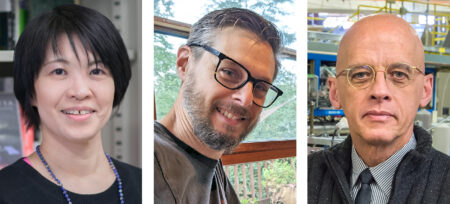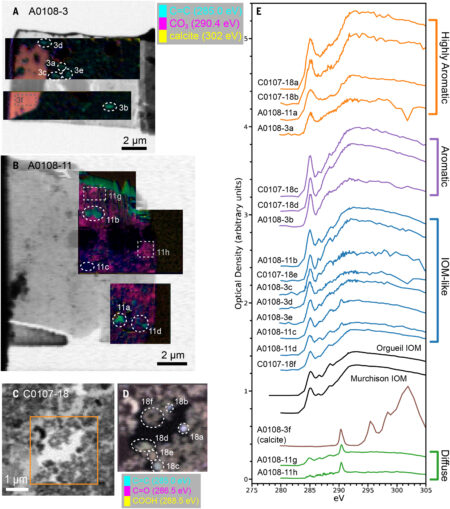SCIENTIFIC ACHIEVEMENT
Samples returned to Earth from the asteroid Ryugu, analyzed in part at the Advanced Light Source (ALS), revealed that the building blocks of life formed 4.6 billion years ago in the extreme cold of space, followed by reaction with water.
SIGNIFICANCE AND IMPACT
The dark, coal-like organic matter in the carbonaceous asteroid could have contributed to the formation of habitable planetary environments.

Rendezvous with Ryugu
In 2014, the Japan Aerospace Exploration Agency (JAXA) launched the Hayabusa2 spacecraft. Its mission: to collect and return samples from the near-Earth asteroid, Ryugu. Asteroids are excellent time capsules, preserving material sourced from the early solar system in pristine condition. With such samples, scientists aim to learn more about how extraterrestrial organic compounds were formed and modified, and whether this material could have eventually seeded life on Earth. Although meteorites can provide valuable information along these lines, they are subject to terrestrial weathering and other contamination from a planet teeming with life.
Hayabusa2 returned to Earth in 2020 to drop off a capsule containing about 5 grams of extraterrestrial material. The spacecraft then left Earth orbit for an extended mission to a smaller asteroid, called 1998 KY26. The samples it left behind were carefully curated and distributed to teams around the world for study.
Solar system under the microscope
In the portion of the sample analysis described here, an international team of 130 researchers, led by Hikaru Yabuta at Hiroshima University, received a share of the irreplaceable Ryugu particles for studies of their organic (carbon-based) content. They examined intact Ryugu grains and insoluble carbonaceous residues isolated by acid treatment.

At ALS Beamline 5.3.2.2, the researchers used scanning transmission x-ray microscopy (STXM) to identify discrete grains of organic material (about 200 nm in size) for further examination by x-ray absorption near-edge structure (XANES) spectroscopy. The beamline enables the acquisition of elemental maps and functional group compositions in submicron-sized sample areas with a spatial resolution below 30 nm.
Other analytical techniques that were performed elsewhere included infrared microspectroscopies, electron microscopy, and nanometer-scale mass spectrometry. Coordinated analytical protocols were established and rehearsals were conducted for two years before the scheduled return of the samples. The researchers carefully planned for a year of sample analysis, and successfully accomplished their mission as scheduled, a testament to their professional experience and skill.
Ryugu’s chemical evolution

Based on the XANES spectra, the carbon in Ryugu was classified into four representative types: highly aromatic (~25% of individual carbon grains), aromatic (~35% of individual grains), insoluble organic matter (IOM) (~40% of individual grains), and diffuse carbon. The data also provides evidence that the organic matter reacted with liquid water on Ryugu’s parent body at various levels, similar to primitive carbonaceous chondrites (the type of meteorites thought to be most closely related). However, those meteorites show predominantly IOM-like XANES spectra, with only occasional highly aromatic grains. Further analysis of the Ryugu samples is planned to explore the cause of this diversity in composition.
The overall picture that emerges from the data is that Ryugu’s organic matter probably formed in the interstellar medium or the solar system’s protoplanetary disk, 4.6 billion years ago. It was then incorporated into Ryugu’s parent body, where it experienced varying degrees of reactions with liquid water. An impact ejected material from the parent body, which reassembled to form Ryugu. Further revelations await ongoing Ryugu investigations, as well as the NASA OSIRIS-REx mission, due to return with samples from the asteroid Bennu this September.
Contact: Hikaru Yabuta
Researchers: H. Yabuta (Hiroshima University), B. De Gregorio (U.S. Naval Research Laboratory), D. Kilcoyne (ALS), et al. Full author list available online.
Funding: Japan Society for the Promotion of Science, National Institutes of Natural Sciences (Japan), National Center for Space Studies (France), European Research Council, National Aeronautics and Space Administration, and Paris Ile-de-France Region. Operation of the ALS is supported by the U.S. Department of Energy, Office of Science, Basic Energy Sciences program.
Publication: H. Yabuta, B. De Gregorio, D. Kilcoyne, et al., “Macromolecular organic matter in samples of the asteroid (162173) Ryugu,” Science 379, abn9057 (2023), doi:10.1126/science.abn9057. Full author list available online.
ALS SCIENCE HIGHLIGHT #483